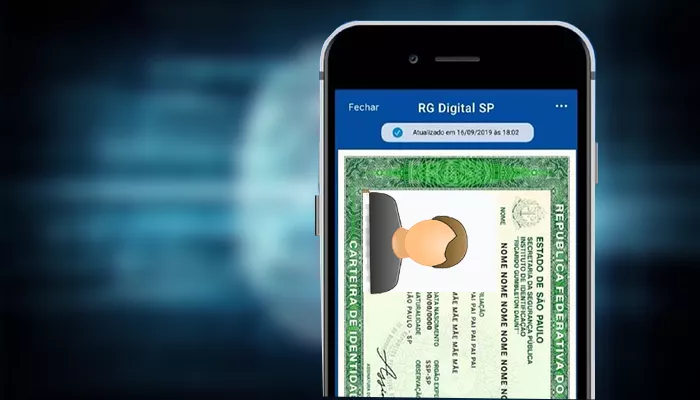RG Digital – No cenário da crescente digitalização que permeia todas as esferas da sociedade, até mesmo documentos de identificação pessoal estão passando por uma revolução tecnológica.
Um exemplo notável que ilustra essa crescente tendência é a evolução do tradicional Registro Geral (RG) para sua versão digital.
Essa transformação traz consigo inúmeras vantagens e desafios, tanto para os cidadãos quanto para as autoridades responsáveis.
Enfim, exploraremos o conceito de RG Digital, suas implicações e o que essa mudança representa para a sociedade moderna.

Imagem Canva Pro – Google
O Documento Digital é uma versão eletrônica do tradicional Registro Geral, documento de identificação pessoal amplamente utilizado em diversos países.
O RG simplifica o acesso às informações de identificação e traz praticidade em interações com serviços que demandam comprovação de identidade.
A carteira de identidade revoluciona a maneira como carregamos nossos dados pessoais, oferecendo conveniência e segurança em um único dispositivo.
O código QR pode ser lido por dispositivos eletrônicos, como smartphones e leitores específicos, facilitando a verificação da identidade do indivíduo.
A maior vantagem do RG online é a conveniência, eliminando a necessidade de portar um documento físico suscetível a perdas ou danos.
Com um smartphone, têm acesso instantâneo a sua identificação em praticamente qualquer lugar.
O novo RG digital representa um marco na modernização dos documentos de identificação, simplificando a verificação de identidade por meio da tecnologia.
Isso é especialmente útil em situações de emergência, viagens e transações cotidianas.
A inclusão de medidas biométricas no RG Digital, como impressões digitais e reconhecimento facial, aumenta significativamente a segurança do documento.
Isso dificulta a falsificação e o uso indevido, uma vez que os dados biométricos são únicos para cada indivíduo e não podem ser facilmente replicados.
Ademais, a carteira de identidade digital inova a forma como provamos nossa identificação, tornando o processo mais eficiente e seguro em um mundo digitalizado.
O App de identidade digital oferece uma maneira prática e segura de acessar e compartilhar informações pessoais em diversas situações.
A adoção do RG Digital também traz benefícios ambientais, reduzindo a necessidade de impressão em papel e plástico para a produção de cartões físicos.
Isso contribui para a redução do consumo de recursos naturais e para a diminuição da pegada de carbono associada à produção de documentos de identificação tradicionais.
Essa transição para o RG Online resulta em uma significativa economia de recursos naturais e uma considerável redução na emissão de gases de efeito estufa.
Portanto, a nova identidade digital reconfigura a forma como nos apresentamos no mundo virtual, trazendo simplicidade e segurança às nossas interações online.
Embora benéfica, a mudança para o Documento Digital apresenta desafios, incluindo inclusão digital e garantia de segurança e privacidade.
A principal preocupação é a inclusão digital, uma vez que nem todos têm acesso a smartphones ou à internet.
Portanto, políticas devem ser implementadas para garantir que todos os cidadãos possam adquirir e utilizar o Documento Digital, sem criar uma exclusão ainda maior.
O aplicativo de RG digital proporciona uma maneira ágil e segura de acessar e controlar as informações de identificação, simplificando as interações cotidianas.
A introdução do RG Digital levanta questões legais e regulatórias que precisam ser cuidadosamente consideradas.
É necessário definir regras claras para a validade do RG Digital em diversas situações, como viagens, operações bancárias e votações.
Além disso, é essencial definir como lidar com situações em que um indivíduo perde o acesso ao seu RG ou é vítima de roubo de identidade.
Com o meu RG digital, tenho acesso instantâneo à minha identificação e posso simplificar várias transações do dia a dia.
O RG Digital representa uma mudança significativa na forma como os cidadãos se identificam e interagem com serviços e instituições.
A conveniência, a segurança aprimorada e os benefícios ambientais são aspectos atrativos dessa inovação.
Para obter o RG Digital, siga as diretrizes das autoridades locais através de plataformas oficiais ou aplicativos dedicados.
Por fim, à medida que a sociedade avança em direção a uma era cada vez mais digital, o Documento digital é apenas um exemplo das muitas transformações que estamos testemunhando.